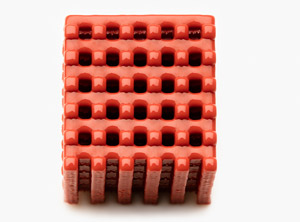WACKER
World's first industrial 3D printer for silicones to debut at "K 2016" / Ability to make customized and complex products / Technology centre in Germany under construction
 The final silicone product does not differ much from injection-moulded parts, Wacker said (Photo: Wacker) |
Germany’s Wacker Chemie (Munich; www.wacker.com) will showcase an industrial 3D printer for silicones at “K 2016” (www.k-online.com). The trade fair kicks off in Düsseldorf / Germany on 19 October. Wacker said it is the world’s first industrial-scale 3D printer for silicones and marks the successful outcome of two years of development.
The “ACEO” Imagine Series K printer is based on Wacker’s “ACEO” technology which uses a drop-on-demand method where tiny silicone droplets are deposited on a substrate. The silicone is formulated so that the droplets flow together before curing begins. The droplets and layers produce a homogeneous product that does not differ much from injection-moulded parts, Wacker explained.
Bernd Pachaly, head of Wacker’s silicone research, said the printer can be used to make parts and assemblies with complex geometries as well as products that were previously impossible to produce.
The automotive and aerospace industries are currently the main customers for 3D printing, also known as additive printing, while medical applications are growing the fastest. Pachaly noted that biomodelling and customised geometries are also particularly promising. “In these types of applications, silicones can display their favourable properties particularly well. Silicones are heat resistant, flexible at low temperatures, transparent and biocompatible. They can furthermore be pigmented in any colour and have good damping properties,” he said.
From August 2016, Wacker will be offering services for 3D printing with silicone. Customers will be able to upload their own designs in a webshop and order printed parts. Consultation and development services for designing and manufacturing silicone parts or assemblies will also be provided.
The company is currently building its own technology centre – the “ACEO” campus – near its main site in Burghausen where customers will be able to test their own product ideas in an Open Print Lab. A completion date for the centre was not given.
The “ACEO” Imagine Series K printer is based on Wacker’s “ACEO” technology which uses a drop-on-demand method where tiny silicone droplets are deposited on a substrate. The silicone is formulated so that the droplets flow together before curing begins. The droplets and layers produce a homogeneous product that does not differ much from injection-moulded parts, Wacker explained.
Bernd Pachaly, head of Wacker’s silicone research, said the printer can be used to make parts and assemblies with complex geometries as well as products that were previously impossible to produce.
The automotive and aerospace industries are currently the main customers for 3D printing, also known as additive printing, while medical applications are growing the fastest. Pachaly noted that biomodelling and customised geometries are also particularly promising. “In these types of applications, silicones can display their favourable properties particularly well. Silicones are heat resistant, flexible at low temperatures, transparent and biocompatible. They can furthermore be pigmented in any colour and have good damping properties,” he said.
From August 2016, Wacker will be offering services for 3D printing with silicone. Customers will be able to upload their own designs in a webshop and order printed parts. Consultation and development services for designing and manufacturing silicone parts or assemblies will also be provided.
The company is currently building its own technology centre – the “ACEO” campus – near its main site in Burghausen where customers will be able to test their own product ideas in an Open Print Lab. A completion date for the centre was not given.
08.07.2016 Plasteurope.com [234495-0]
Published on 08.07.2016

 German version of this article...
German version of this article...